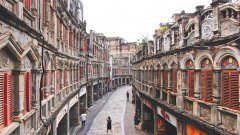New museum of African American history opens in U.S. capital amid nationwide racial tensions
WASHINGTON, Sept. 24 (Xinhua) -- The past is never dead. It's not even past, wrote William Faulkner, a late U.S. Nobel Prize winner.
Resonating to the remarks, a new, grand museum setting for the tale of African American history and achievement, the only one in the U.S. exclusively focused on African-Americans, officially opened in central Washington D.C., U.S. capital, on Saturday.
The opening came amid a new wave of racial tensions especially between black people and police, following the police shooting deaths of black men in Tulsa, Oklahoma, and Charlotte, North Carolina, earlier this month.
"We're not a burden on America or a stain on America or an object of shame and pity for America. We are America," Barack Obama, the first African-American U.S. president, said at the National Museum of African-American History and Culture.
The museum, chronicling black history from the 15th century to present, has collected tens of thousands of artifacts largely donated by ordinary people across the United States.
Among more than 3,000 items on display are a slave cabin, a bill of sale for a 16-year-old girl for 600 dollars, shackles used on slaves, a Justice 4 Trayvon placard and a Black Lives Matter T-shirt. Curators also collected artifacts and videos about the death of Freddie Gray while in the custody of Baltimore police.
"It reminds us that routine discrimination and Jim Crow aren't ancient history. It's just a blink in the eye of history," Obama said, expecting the museum could elevate the often-overlooked impact of black Americans and help others better understand the breadth of the American story.
"Perhaps it can help a white visitor understand the pain and anger of demonstrators in places like Ferguson (Missouri) and Charlotte," said Obama.
"It can also help black visitors appreciate the fact that not only is this younger generation carrying on traditions of the past, but within the white communities across the nation, we see the sincerity of law enforcement officers and officials who, in fits and starts, are struggling to understand and trying to do the right thing," he immediately added.
The museum also contains many iconic items celebrating the African-Americans' achievements in sports, music, television, film and so on, including singer Michael Jackson's fedora hat, boxer Muhammad Ali's headgear and baseball star Jackie Robinson's bat.
"This national museum helps to tell a richer and fuller story of who we are," the president concluded.
"At this time in our country, there is a great need for contextualization and the clarity that comes from understanding one's history," Lonnie Bunch III, founding director of the museum, wrote in a recent issue of Smithsonian magazine.
"I hope that the museum can play a small part in helping our nation grapple with its tortured racial past. And maybe even help us find a bit of reconciliation." he wrote.
The museum, constructed from Feb. 2014 under a bill signed by then U.S. president George Bush in 2003, is a three-tiered building whose exterior is made up of 3,600 bronze-colored panels. The architects said they drew on imagery from both African and American histories for the outer layer, trying to express faith, hope and resilience, according to a CNN report.
"A great nation doesn't hide its history," Bush said at the opening ceremony, "It faces its flaws, and corrects them."















